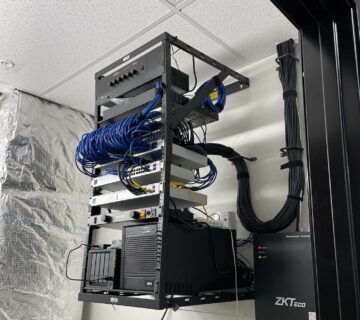Architects, A/V Professionals, and Designing for the Future
Designing for the future will require increased collaboration between architects and A/V professionals.
At the onset of the COVID-19 pandemic, many businesses and employees struggled to embrace the quick shift to remote work. Now, working from home and the tools that enable it have been more or less normalized.
While some studies have shown that remote work may increase productivity, and multiple tech giants—such as Facebook and Twitter—have committed to remote work for the foreseeable future, working from home simply can’t reproduce what some employees consider the best part of their jobs: enjoying the company of their coworkers.
How then can business owners work with architects to update their offices and encourage healthy interactions between employees? How will the workplace adapt to a post-pandemic world? And where do A/V professionals fit into this equation?
In this blog, we consider how architects and A/V professionals can collaborate to design workspaces that promote collaboration and employee well-being.
What does the future of work look like?
In his recent article for The New Yorker—“Has the Pandemic Changed the Office Forever?”—John Seabrook chronicles how R/GA, a global advertising and marketing agency, is updating its approach to physical office space. After shifting to remote work at the beginning of the pandemic and later querying employees for feedback on that transition, R/GA is reducing its real estate investments and designing hybrid offices for its employees.
If R/GA’s plans are indicative of a larger trend, then the workplace of the future is smaller and more adaptable, with reservable work stations replacing assigned desks and open, collaborative hubs replacing the few closed offices that survived the era of open floor plans.
Yes, “Has the Pandemic Changed the Office Forever?” focuses on multinational companies, and not small businesses in Midwestern cities. But in light of the pandemic, businesses of all sizes across the country are confronting the uncertain future of corporate offices.
One thing is almost certain. Remote work isn’t going away. That means offices have to change in order to support remote workers.
If hybrid offices, or offices that serve as collaboration hubs for both on-site and virtual employees, are the offices of the future, then how can architects and A/V professionals work together to design these types of offices?
New opportunities for architects and A/V professionals to collaborate
As architects imagine new ways to approach physical offices, A/V professionals are uniquely positioned to provide consultation and design services. Here are three ways A/V professionals can help architects realize hybrid offices.
-
Providing acoustic solutions for bustling workspaces
Remote work’s increase in popularity may mean that fewer employees will commute to work each day, but it doesn’t necessarily mean that their offices will be any quieter. As private offices give way to collaborative areas, and as employees video conference with remote colleagues and clients, offices will most likely continue to be noisy—unless architects address distracting sound levels, that is.
A/V professionals can help architects manage sound in bustling offices by designing and installing acoustic solutions, such as acoustic panels or sound masking technology. Not only do these solutions help employees maintain their focus, they also limit reverberations and echoes.
-
Navigating architectural constraints
A/V experts provide user-friendly technology that unites a range of audio, video, and data management solutions. They also design custom systems that navigate the unique architectural constraints of clients’ buildings. These skills make A/V professionals invaluable partners for architects, as their expertise helps eliminate the unnecessary costs that come with treating A/V system design as an afterthought.
-
Designing with the future in mind
As businesses continue to adapt to changing demands, both flexibility and future planning are essential. A/V professionals can work with architects to design and install custom A/V systems that accommodate expansion and anticipate future needs—so that each client’s technological infrastructure can grow organically within their office’s blueprint.
A Trusted A/V Partner of Indiana Architects
When architects include A/V professionals in the planning phases of their projects, A/V professionals can help architects design workspaces that leverage technology to increase productivity. From providing acoustic solutions that limit distractions to outfitting meeting rooms with efficient video conferencing equipment, A/V professionals are invaluable partners for architects.
Need an experienced A/V partner for your next project? Contact AV Designers today. Since 1992, our team of A/V experts has worked closely with Indiana architects to provide user-friendly A/V solutions for boardrooms, conference rooms, lobbies and office, retail, and dining spaces.






